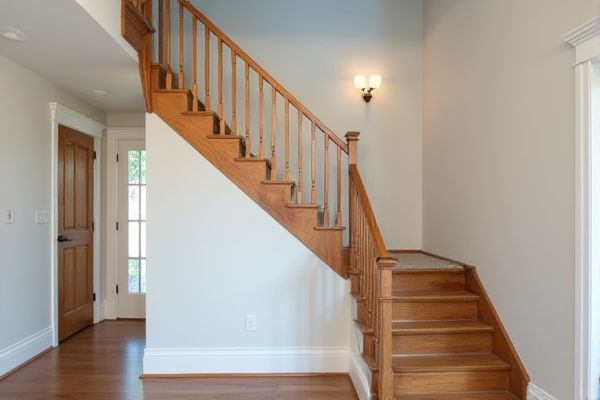
Retrofitted staircases offer a cost-effective solution by adapting existing structures to improve safety and aesthetics without complete overhaul, while new construction staircases provide full design flexibility and compliance with modern building codes from the ground up. Discover which staircase option best fits Your space and renovation goals by exploring the detailed comparisons ahead.
Table of Comparison
| Feature | Retrofitted Staircase | New Construction Staircase |
|---|---|---|
| Cost | Typically lower, uses existing framework | Higher, includes full materials and labor |
| Installation Time | Shorter, minimal demolition needed | Longer, built from scratch |
| Design Flexibility | Limited by existing structure | Full customization options |
| Structural Integrity | Depends on current building condition | Engineered for maximum strength |
| Building Code Compliance | Must adapt to existing constraints | Designed to meet modern codes |
| Disruption | Less intrusive, ideal for renovations | More disruptive during construction |
| Lifespan | Varies, potentially shorter | Longer with proper materials |
Introduction to Staircase Options
Retrofitted staircases adapt existing structures to fit new design requirements, offering a cost-effective solution with minimal disruption. New construction staircases provide full customization, allowing you to design stair geometry, materials, and safety features from the ground up. Choosing between these options depends on your budget, project scope, and desired aesthetic impact.
What is a Retrofitted Staircase?
A retrofitted staircase is an existing staircase that has been modified or upgraded to meet current safety standards, design preferences, or structural requirements without complete replacement. Unlike new construction staircases, retrofitting involves working within the constraints of the original framework to improve durability, aesthetics, or accessibility. You can preserve the building's character and reduce renovation costs by opting for a retrofitted staircase rather than installing a brand-new one.
Defining New Construction Staircases
New construction staircases are built as an integral part of the initial building design, allowing for precise customization to meet architectural specifications and building codes. These staircases typically offer greater design flexibility, structural stability, and seamless integration with surrounding finishes compared to retrofitted staircases. Material choices and dimensions can be optimized during construction, ensuring maximum safety, aesthetic appeal, and long-term durability.
Cost Comparison: Retrofitted vs New
Retrofitted staircases typically cost 20-40% less than new construction staircases due to reduced labor and materials since they utilize existing structures. New construction staircases offer more design flexibility but incur higher expenses from demolition, framing, and finishing work. Your choice depends on budget constraints and whether you prioritize cost savings or customized design options.
Installation Time and Complexity
Retrofitted staircases typically require more installation time and complexity due to the need to adapt to existing structures, often involving precise measurements and potential modifications to surrounding walls or floors. New construction staircases allow for streamlined installation processes since they are built alongside the main structure, enabling easier customization and integration of materials. Understanding these differences helps you plan your project timeline and budget more effectively.
Design Flexibility and Aesthetics
Retrofitted staircases often face constraints due to existing structural elements, limiting design flexibility compared to new construction staircases that allow customization from the ground up. New construction staircases provide broader aesthetic options, including varied materials, shapes, and finishes tailored to your specific style preferences. Your choice impacts not only the staircase's visual appeal but also how seamlessly it integrates with the overall architectural design.
Structural Integrity and Safety
Retrofitted staircases often require careful assessment to ensure structural integrity because they must adapt to existing frameworks, which can present challenges like uneven load distribution or compromised support elements. New construction staircases allow for precise engineering and materials selection, enhancing overall safety and compliance with modern building codes. Your choice should consider that properly designed new staircases typically offer greater reliability and longevity compared to retrofitted options.
Impact on Home Value
Retrofitted staircases can enhance your home's value by preserving original architectural features while improving safety and functionality, appealing to buyers seeking character with modern updates. New construction staircases offer greater design flexibility, allowing customization that can elevate the overall aesthetic and property worth, especially in luxury markets. Choosing between the two depends on balancing authentic charm with contemporary appeal to maximize return on investment.
Maintenance and Longevity
Retrofitted staircases often require more frequent maintenance due to the challenges of integrating new elements with existing structures, which can lead to faster wear and potential structural issues. New construction staircases benefit from modern materials and techniques that enhance durability and reduce upkeep, providing longer-lasting performance with less intervention. Your choice between retrofitting or new construction directly impacts ongoing maintenance efforts and the overall lifespan of the staircase.
Choosing the Best Option for Your Home
Retrofitted staircases offer a cost-effective and quicker solution by adapting existing structures, while new construction staircases provide complete design freedom and can enhance your home's value with modern materials and styles. Your decision should balance budget constraints, structural limitations, and aesthetic preferences to ensure the staircase complements your home's overall design. Evaluating space, functionality, and long-term goals helps determine whether retrofitting or new construction best suits your renovation needs.
 homyna.com
homyna.com